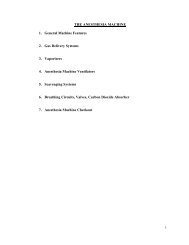BUMC Basics.pdf - Anesthesia Home
BUMC Basics.pdf - Anesthesia Home
BUMC Basics.pdf - Anesthesia Home
You also want an ePaper? Increase the reach of your titles
YUMPU automatically turns print PDFs into web optimized ePapers that Google loves.
101<br />
RENAL<br />
ACID/BASE DISTURBANCES<br />
Quick guide to acid/base disturbances:<br />
1. Look at the Ph:<br />
7.40 = normal<br />
7.45 = alkalemia<br />
Decide primary disorder (this is if compensated):<br />
Primary disorder pH HCO3 paCO2<br />
Metabolic<br />
acidosis<br />
↓ ↓ ↓<br />
Metabolic<br />
alkalosis<br />
↑ ↑ ↑<br />
Resp acidosis ↓ ↑ ↑<br />
Resp alkalosis ↑ ↓ ↓<br />
2. Determine if degree of compensation is appropriate:<br />
Metabolic acidosis: PCO2 = HCO3 + 15 (or the Winter’s<br />
Equation — pCO2 = 1.5(HCO3) + 8 +/- 2)<br />
Also, with metabolic acidosis the last decimal digits of<br />
the pH should equal pCO2 +/-2.<br />
Metabolic alkalosis: Increase in PaCO2 = 0.75 x change<br />
in HCO3 (HCO3 + 15 works fairly well)<br />
Respiratory acidosis:<br />
Acute: for every increase in 10 in pCO2, there is an<br />
increase in HCO3 by 1<br />
Chronic: for every increase in 10 in pCO2, there is an<br />
increase in HCO3 by 4<br />
Respiratory alkalosis:<br />
Acute: for every decrease in 10 in pCO2, there is a<br />
decrease in HCO3 by 2<br />
Chronic: for every decrease in 10 pCO2, there is a<br />
decrease in HCO3 by 5<br />
If not what expected, consider a mixed disorder.




